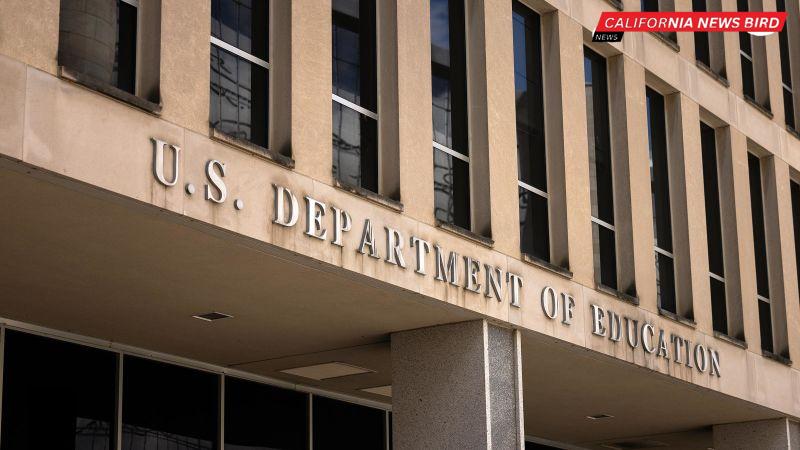/ Jul 04, 2025
Trending

The Trump administration has taken a bold step by drafting an executive order to dismantle the Department of Education. This proposal is a significant development in the ongoing debate about education and federal government involvement. Advocates for this plan, including Trump himself, argue that it is an important move to reduce federal control in education, which they believe overreaches into local matters. However, this initiative is not without controversy and faces various obstacles ahead.
The executive order discussed by the Trump administration aims to initiate the process of reducing the Department of Education’s size and scope. The order will instruct the Education Secretary to create a concrete plan for this reduction. This is not the first time such a move has been proposed, as Trump had previously campaigned on promises to eliminate the department, citing concerns about federal overreach and indoctrination in schools.
While the executive order can set things in motion, it is important to know that only Congress has the power to fully shut down the department. This legislative process will be extremely challenging due to a lack of bipartisan support. Past attempts to abolish or merge the department have fallen short in Congress, and similar outcomes are expected again. In fact, a recent vote in the House to abolish the department did not gather enough votes to pass, with only 161 representatives supporting the motion.
Interestingly, amidst the push to dismantle the Department of Education, the Department of Government Efficiency (DOGE), under Elon Musk’s leadership, is also involved. DOGE staff members have been working with the Education Department to streamline processes and access various internal systems. There are concerns about data privacy and the potential repercussions of combining functions between these two departments.
Both legal and public resistance to this executive order is expected. Experts are questioning its legitimacy and effectiveness, suggesting that the plan may face significant pushback from various groups. The National Student Legal Defense Network has expressed its intention to explore potential legal challenges against efforts to dismantle the department. Moreover, opinions on the Education Department remain divided across partisan lines, with some advocating for its preservation while others support its dismantling.
If the Department of Education were to be eliminated, many worry that vital programs, particularly those that support low-income and disabled students, could be jeopardized. The Department of Education has played a critical role in managing significant funding and enforcing civil rights laws in schools. There is recognition that even in the event of the department’s elimination, some of its funding and programs might be transferred to other federal agencies, a process that would require careful planning and legislative approval.
Public opinion on the Department of Education has been mixed, with many people expressing concern over the direction of education policy in the United States. Some argue that discontinuing the department would lead to a collapse of essential support systems for schools across the nation. Additionally, Trump’s ideas align with a broader conservative agenda that seeks to reclaim local control over education.
As the Trump administration continues to draft this executive order, many questions remain about its actual implementation. Policymakers must grapple with the implications of potentially dismantling a department that has been a part of the federal government since its creation in 1979 and administers critical federal grant programs and the federal student loan system. The coming weeks and months will be crucial as this situation develops, with possible hearings in Congress and continued scrutiny from both supporters and opponents of the plan.
| Key Points | Details |
|---|---|
| Executive Order Purpose | To initiate the dismantling of the Department of Education. |
| Congressional Action Required | Only Congress can fully abolish the department. |
| Possible Transfer of Programs | Some educational programs may be moved to other agencies. |
| Public Opinion | Divided, with concerns over educational support. |
The Trump administration has taken a bold step by drafting an executive order to dismantle the Department of Education. This proposal is a significant development in the ongoing debate about education and federal government involvement. Advocates for this plan, including Trump himself, argue that it is an important move to reduce federal control in education, which they believe overreaches into local matters. However, this initiative is not without controversy and faces various obstacles ahead.
The executive order discussed by the Trump administration aims to initiate the process of reducing the Department of Education’s size and scope. The order will instruct the Education Secretary to create a concrete plan for this reduction. This is not the first time such a move has been proposed, as Trump had previously campaigned on promises to eliminate the department, citing concerns about federal overreach and indoctrination in schools.
While the executive order can set things in motion, it is important to know that only Congress has the power to fully shut down the department. This legislative process will be extremely challenging due to a lack of bipartisan support. Past attempts to abolish or merge the department have fallen short in Congress, and similar outcomes are expected again. In fact, a recent vote in the House to abolish the department did not gather enough votes to pass, with only 161 representatives supporting the motion.
Interestingly, amidst the push to dismantle the Department of Education, the Department of Government Efficiency (DOGE), under Elon Musk’s leadership, is also involved. DOGE staff members have been working with the Education Department to streamline processes and access various internal systems. There are concerns about data privacy and the potential repercussions of combining functions between these two departments.
Both legal and public resistance to this executive order is expected. Experts are questioning its legitimacy and effectiveness, suggesting that the plan may face significant pushback from various groups. The National Student Legal Defense Network has expressed its intention to explore potential legal challenges against efforts to dismantle the department. Moreover, opinions on the Education Department remain divided across partisan lines, with some advocating for its preservation while others support its dismantling.
If the Department of Education were to be eliminated, many worry that vital programs, particularly those that support low-income and disabled students, could be jeopardized. The Department of Education has played a critical role in managing significant funding and enforcing civil rights laws in schools. There is recognition that even in the event of the department’s elimination, some of its funding and programs might be transferred to other federal agencies, a process that would require careful planning and legislative approval.
Public opinion on the Department of Education has been mixed, with many people expressing concern over the direction of education policy in the United States. Some argue that discontinuing the department would lead to a collapse of essential support systems for schools across the nation. Additionally, Trump’s ideas align with a broader conservative agenda that seeks to reclaim local control over education.
As the Trump administration continues to draft this executive order, many questions remain about its actual implementation. Policymakers must grapple with the implications of potentially dismantling a department that has been a part of the federal government since its creation in 1979 and administers critical federal grant programs and the federal student loan system. The coming weeks and months will be crucial as this situation develops, with possible hearings in Congress and continued scrutiny from both supporters and opponents of the plan.
| Key Points | Details |
|---|---|
| Executive Order Purpose | To initiate the dismantling of the Department of Education. |
| Congressional Action Required | Only Congress can fully abolish the department. |
| Possible Transfer of Programs | Some educational programs may be moved to other agencies. |
| Public Opinion | Divided, with concerns over educational support. |
It is a long established fact that a reader will be distracted by the readable content of a page when looking at its layout. The point of using Lorem Ipsum is that it has a more-or-less normal distribution of letters, as opposed to using ‘Content here, content here’, making it look like readable English. Many desktop publishing packages and web page editors now use Lorem Ipsum as their default model text, and a search for ‘lorem ipsum’ will uncover many web sites still in their infancy.
It is a long established fact that a reader will be distracted by the readable content of a page when looking at its layout. The point of using Lorem Ipsum is that it has a more-or-less normal distribution of letters, as opposed to using ‘Content here, content here’, making it look like readable English. Many desktop publishing packages and web page editors now use Lorem Ipsum as their default model text, and a search for ‘lorem ipsum’ will uncover many web sites still in their infancy.
The point of using Lorem Ipsum is that it has a more-or-less normal distribution of letters, as opposed to using ‘Content here, content here’, making

The point of using Lorem Ipsum is that it has a more-or-less normal distribution of letters, as opposed to using ‘Content here, content here’, making it look like readable English. Many desktop publishing packages and web page editors now use Lorem Ipsum as their default model text, and a search for ‘lorem ipsum’ will uncover many web sites still in their infancy.

The information provided by California News Bird is for general informational purposes only. While we strive to ensure that the content we publish is accurate, current, and reliable, we make no representations or warranties of any kind, express or implied, about the completeness, accuracy, reliability, or availability of the information, products, or services contained on our website.